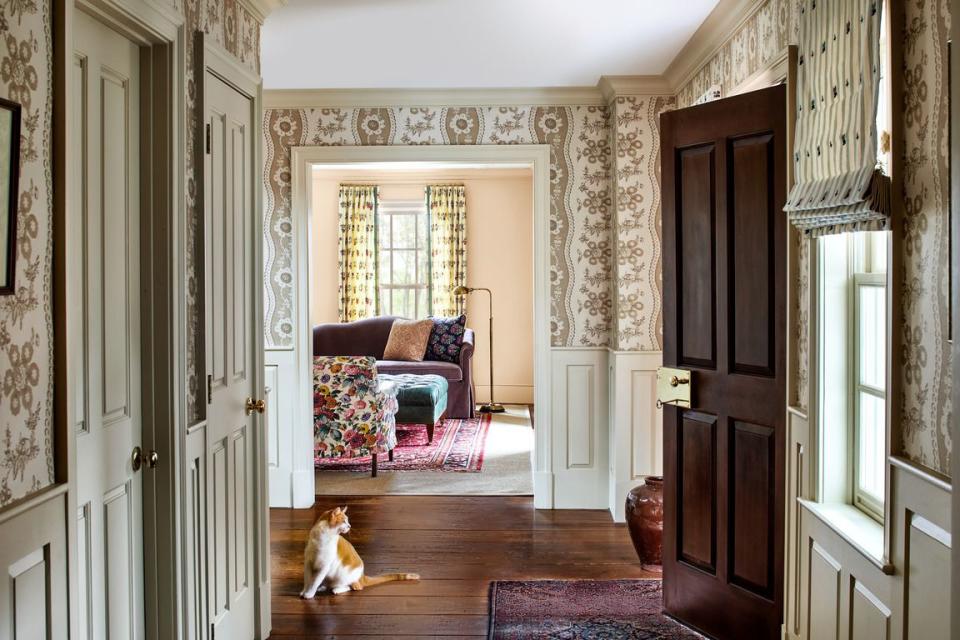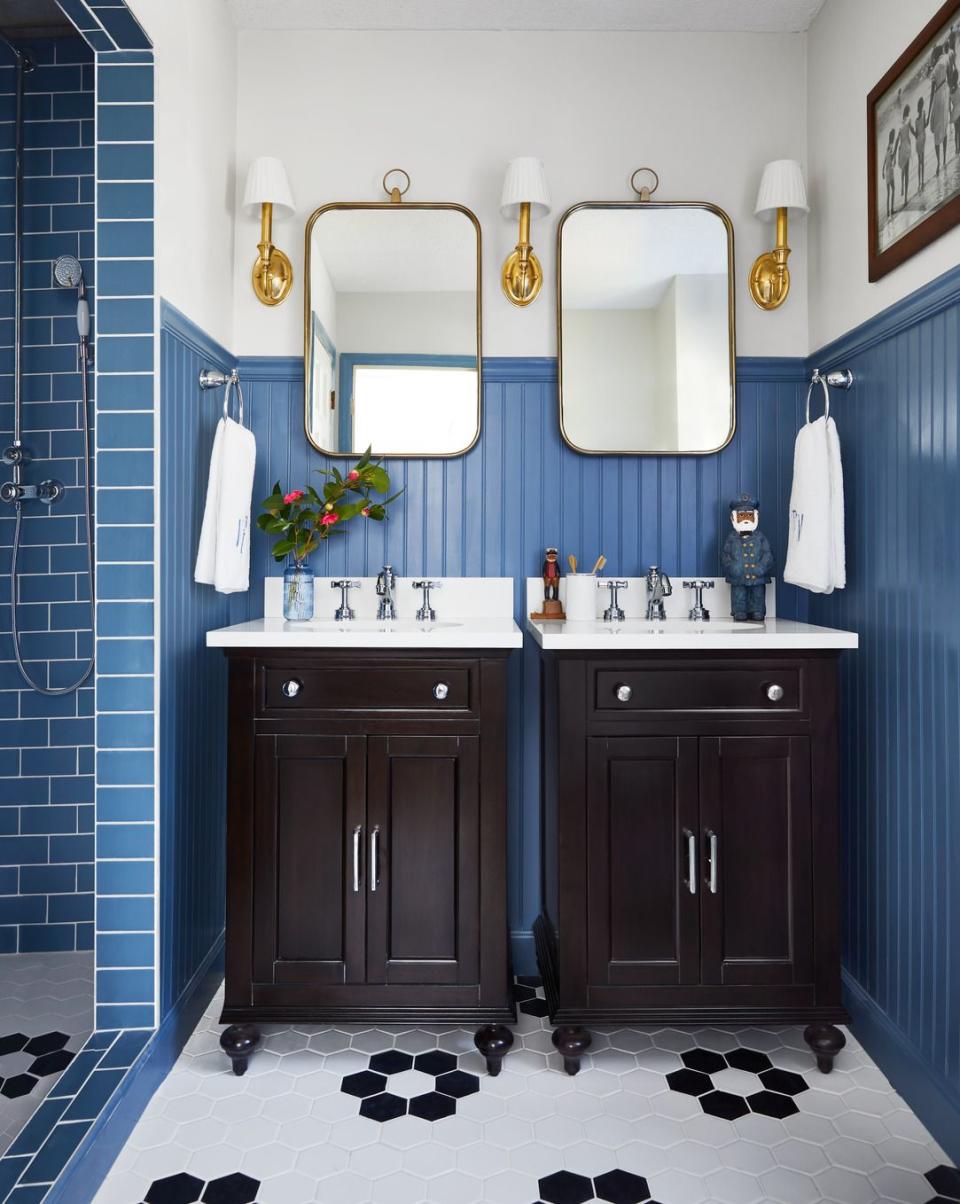Beadboard vs. Wainscoting—Do You Know the Difference?

"Hearst Magazines and Yahoo may earn commission or revenue on some items through these links."
Applying millwork to walls is a sure-fire way to wake up a sleepy room. Just like the exterior architecture of a house visually expresses a home’s style, amped-up walls of interior spaces also add character cues. Beyond sheet rock that’s painted or wallpapered, decorative paneling in the form of beadboard and wainscoting adds texture and brings another dimension to rooms. But while beadboard and wainscoting both refer to decorative wall treatments, the terms are often confused and they do not mean the same thing. Here, we’ll dive into beadboard and wainscoting definitions alongside examples of ways to use them to express your style.
What’s the Difference Between Beadboard and Wainscoting?
It’s easy to confuse beadboard and wainscoting because they are often misused interchangeably, but they are not synonymous terms. Beadboard refers a specific type of wall cladding that is made of narrow planks usually placed vertically on the wall. Wainscoting is a broader term that describes any type of molding (beadboard, board-and-batten, and V-groove are among some of the common types) that covers a portion of a wall. In other words, beadboard is the material that can be used as wainscoting.
What is Beadboard?
Beadboard refers to thin, narrow strips of wood (or a material that mimics the look of wood such as medium-density fiberboard, PVC, or vinyl) with a rounded “bead” edge that runs the length of the grooves between each strip. Historically, beadboard dates back to the Victorian era. It was made inexpensively from wood scraps and was used to insulate and protect walls in high-traffic areas. Today, beadboard paneling, commonly available in 4- by 8-foot sheets with planks measuring 2 1/2 inches wide, is used as a decorative element, applied to walls to add charm, texture, and architectural interest. From historic homes to new houses, beadboard spans myriad styles ranging from coastal capes, cottages, and bungalows to cabins and farmhouses.

What is Wainscoting?
Wainscoting describes decorative wood molding that covers a portion of a wall that is typically painted or stained. The height of wainscoting can vary, but it usually follows a one-third ratio in height, leaving the remaining wall available to paint or wallpaper. Historically, wainscoting was functional: It helped to insulate rooms and protected walls from damage. For example, a “chair rail” is the molding cap at the top of the wainscot positioned at the height of the back of a chair (about the bottom third of a wall) to protect the walls from bumps. Often, the wall that is exposed above the wainscoting is painted or wallpapered.
RELATED: 35+ Wainscoting Ideas to Add Character to Every Room in Your Home
Three Types of Wainscoting
From cozy charm to relaxed formality, these three forms of wainscoting help set the stage of a room.
• Raised Panel. This traditional style of wainscoting, which first became popular in 17th-century England, features panels set flush against surrounding trim with raised beveled edges around each panel, almost mimicking a repeating picture-frame effect on the wall. The style can veer more formal and polished, paired with stately antiques in dressed-up dining rooms of Colonial and Victorian homes, or it can project a relaxed formality, mixed with warm woods and rustic furniture in the well-trodden entryway of a country house.

• Beadboard. Used as wainscoting, beadboard brings instant nostalgia to a room without overtaking it. The narrow vertical boards can add height, for example, by running the wainscot up two-thirds of a wall. Beadboard wainscoting is a go-to solution for adding interest in the smallest of places such as a mudroom or a secondary bathroom.

• Flat Panel. This streamlined style of wainscoting is the opposite of the raised panel— there are no beveled edges and the panels are recessed in symmetrical sizes along a portion of a wall. The style is casual yet organized and commonly seen in Craftsman-style bungalows.

RELATED: Tambour Paneling Is the Latest Must-Have Home Feature and a Favorite of HGTV Stars
How to Use Beadboard in a Bathroom
Go all-in on beadboard in small spaces like a bathroom to cover the ceiling and the walls to create a cozy jewel box effect. Or, use it strategically, on the wall behind the sink, so the beadboard acts as a backsplash. In small or large doses, beadboard is a cost-effective way to inject farmhouse personality into a practical space.

RELATED: 80+ Bathroom Decorating Ideas to Add Some Soul to Your Bathroom
How to Use Beadboard on a Ceiling
From the east coast down to the deep south, porches featuring beadboard-clad ceilings are as common as the slam of a screen door on a summer day. Often, the ceilings are painted in a contrasting hue (like sky blue, also commonly referred to as haint blue) or finished in a glossy sheen to distinguish it from the rest of the porch’s exterior. Soft woods, such as cedar, work best areas that are exposed to the elements. Inside, beadboard ceilings were common in the bedrooms, baths, and kitchens of 19th- and early 20th-century farmhouses, and the look continues to be popular today.

RELATED: 20 Wood Ceiling Ideas to Bring Your Room Country Charm
How to Use Beadboard in the Mudroom
High-traffic areas need sturdy walls to withstand the scuffs and bumps of daily life, which is why beadboard is a common material for mudrooms in old and new homes. Pair it with shelves, peg rails, or hooks to put the wall to work.

RELATED: 35 Ideas for a More Stylish and Functional Mudroom, According to Designers
You Might Also Like

 Yahoo Lifestyle
Yahoo Lifestyle 
